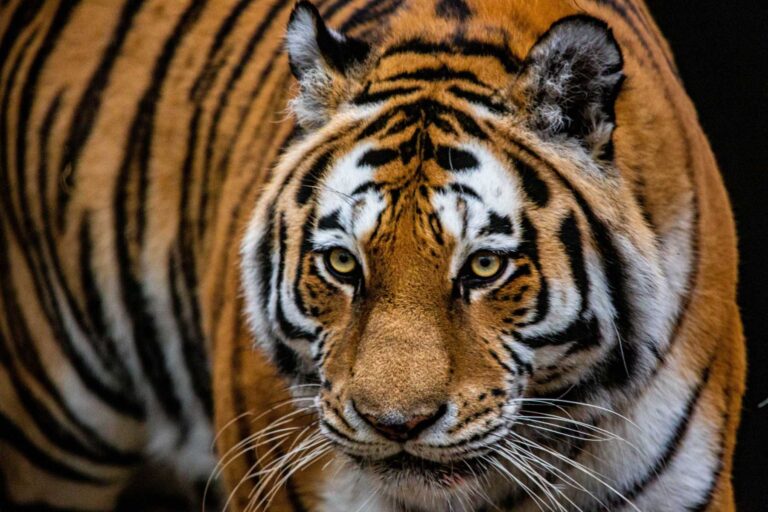Are Tigers Friendly? Exploring the Complexities of Tiger Behavior
Great Resources:
When we think of tigers, the image of a fierce predator roaming through dense jungles often comes to mind. Yet, behind their majestic appearance lies a complex world of behavior and social dynamics. The question arises: Are tigers friendly? To answer this, we explore the intricate tapestry of tiger behavior, exploring their communication, social structure, and human interactions.
Tigers, scientifically known as Panthera tigris, are the largest cat family members revered for their strength, agility, and beauty. Found primarily in Asia, these solitary hunters have captivated the imagination for centuries.
Basic Characteristics of Tigers
| Characteristics | Description |
| Size | Largest member of the cat family |
| Weight | Varied, ranging from 220 to 660 pounds (100-300 kg) |
| Habitat | Dense forests, grasslands, mangrove swamps |
| Diet | Carnivorous, primarily hunt deer, boar, and cattle. |
The Nature of Tigers
Tigers, with their distinctive orange coats adorned with black stripes, possess unique characteristics that set them apart in the animal kingdom. Their large size and solitary nature often lead to misconceptions about their friendliness. However, understanding the nature of tigers goes beyond mere appearances.
In their natural habitat, tigers play a vital role as apex predators, maintaining the balance of ecosystems. Their solitary lifestyle results from evolutionary adaptation to ensure efficient hunting and territorial defense. Despite their reclusive tendencies, tigers exhibit social behaviors, especially during mating and cub-rearing seasons.
Evolutionary Background of Tigers
| Evolutionary Aspect | Description |
| Adaptations | Unique camouflage for hunting and territorial dominance |
| Evolutionary History | Diverged from other big cats approximately 2 million years ago |
| Survival Strategies | Solitary nature to minimize competition for resources |
Social Structure of Tigers
Contrary to popular belief, tigers are not strictly solitary creatures. While they often roam their territories alone, they interact socially, especially during breeding seasons and raising cubs. Female tigers, mainly, display maternal behaviors, fiercely protecting and nurturing their offspring until they become independent hunters.
Male tigers, on the other hand, establish and defend vast territories, marking them with scent and vocalizations to deter potential rivals. These territories serve as crucial hunting grounds and breeding sites, where tigers establish dominance and assert their presence in the wild.
Maternal and Paternal Behaviors Among Tigers
| Behavior | Description |
| Maternal Care | Females raise cubs independently, teaching them hunting skills. |
| Paternal Involvement | Limited, males occasionally participate in cub rearing. |
| Cub Independence | Cubs remain with their mothers for approximately two years before venturing out. |
Communication and Expression
Communication forms the cornerstone of tiger interactions, allowing them to convey intentions, establish dominance, and navigate their social environment. Tigers employ diverse vocalizations, including roars, growls, and chuffs, each serving distinct purposes in their communication repertoire.
In addition to vocalizations, tigers utilize body language to express emotions and assert dominance. Tail flicks, ear positions, and facial expressions convey subtle cues that facilitate individual communication and help maintain social order within tiger populations.
Vocalizations and Their Meanings
| Vocalization | Description |
| Roar | Assert dominance and advertise presence. |
| Growl | Warning signal, indicates aggression. |
| Chuff | Friendly greeting, express contentment |
Human-Tiger Interactions
Both fascination and conflict have marked the relationship between humans and tigers. Throughout history, tigers have been revered as symbols of power and strength in various cultures, yet their predatory nature has also threatened human safety.
Conflicts often arise in regions where human settlements encroach upon tiger habitats as tigers compete for resources and territory. However, instances of tigers displaying friendliness towards humans have been documented, challenging conventional perceptions of their behavior.
Historical Perspectives on Human-Tiger Relationships
| Time Period | Description |
| Ancient Civilizations | Tigers revered as symbols of power and protection. |
| Colonial Era | Tigers hunted for sport and perceived as threats to human safety. |
Factors Influencing Tiger Behavior
The behavior of tigers is shaped by a myriad of factors, including environmental conditions, prey availability, and human interactions. Habitat loss and fragmentation due to deforestation have forced tigers into closer proximity to human settlements, leading to increased instances of conflict and aggression.
In captivity, tigers exhibit behaviors influenced by their surroundings and caretaker interactions. Understanding these factors is crucial for developing effective conservation strategies that mitigate human-tiger conflicts and promote coexistence.
Environmental Factors Affecting Tiger Behavior
| Environmental Factor | Description |
| Habitat Loss | Deforestation and land conversion threaten tiger habitats. |
| Prey Availability | Decline in prey populations affects tiger hunting patterns. |
| Human Encroachment | Increased conflict due to habitat fragmentation |
Misconceptions about Tiger Friendliness
Despite their reputation as solitary hunters, tigers possess complex social behaviors that challenge common misconceptions about their friendliness. Media portrayals often sensationalize tiger aggression, perpetuating fears and stereotypes that overshadow their more nuanced interactions with humans and other animals.
In reality, instances of tigers displaying curiosity and tolerance towards humans have been observed, highlighting the need for a balanced understanding of their behavior beyond simplistic portrayals.
Reality vs. Perception of Tiger Behavior
| Perception | Reality |
| Tigers are solitary | Tigers exhibit social behaviors, especially during breeding seasons. |
| Tigers are aggressive | Tigers display a range of behaviors influenced by context and environment. |
Instances of Tiger Aggression
While tigers are not inherently aggressive towards humans, attacks have often occurred due to territorial disputes, perceived threats, or disturbances to their natural habitat. Understanding the triggers and patterns of tiger aggression is essential for minimizing risks and ensuring human safety in regions where tigers and humans coexist.
Factors Contributing to Tiger Attacks on Humans
| Factor | Description |
| Territory Defense | Tigers may attack intruders perceived as threats. |
| Provocation | Disturbances or surprise encounters may trigger defensive reactions. |
| Habitat Fragmentation | Increased human-tiger encounters due to habitat loss |
Conservation Efforts and Tiger Behavior
Conservation efforts are pivotal in shaping tiger behavior and promoting coexistence between humans and tigers. Conservationists strive to safeguard tiger populations and their natural habitats through habitat protection, anti-poaching measures, and community engagement.
Reintroduction programs aim to restore tiger populations in regions where they have been extirpated, providing opportunities for tigers to reclaim their roles as apex predators and maintain ecological balance.
Impact of Conservation Efforts on Tiger Behavior
| Conservation Measure | Description |
| Habitat Protection | Preserves critical tiger habitats and corridors |
| Anti-Poaching Measures | Deters illegal hunting and trade of tiger parts |
| Community Engagement | Fosters local support for tiger conservation efforts |
Human Encroachment and Tiger Behavior
The encroachment of human settlements into tiger habitats poses significant conservation and safety challenges. As natural habitats diminish, tigers are forced to navigate increasingly fragmented landscapes, leading to conflicts with humans over resources and territory.
Implementing strategies for habitat restoration and land-use planning is crucial for mitigating human-tiger conflicts and preserving critical habitats for tiger populations to thrive.
Human-Tiger Conflict Resolution Strategies
| Strategy | Description |
| Habitat Restoration | Reclaims degraded habitats to provide space for tiger populations. |
| Land-Use Planning | Balances human development with conservation priorities |
| Conflict Mitigation | Implements measures to minimize interactions between tigers and humans |
Case Studies of Tigers in Captivity
Observations of tiger behavior in captive environments offer valuable insights into their social dynamics and interactions with humans. Zoos and sanctuaries provide opportunities for research and education, allowing scientists to study tiger behavior up close and develop strategies for enhancing their welfare in captivity.
Relationship Dynamics Between Tigers and Caretakers
| Caretaker Interaction | Description |
| Enrichment Activities | Stimulate natural behaviors and mental stimulation. |
| Positive Reinforcement | Establish trust and rapport between tigers and caretakers. |
| Behavioral Monitoring | Assess tiger well-being and identify signs of stress. |
Ethical Considerations in Human-Tiger Interactions
Humans bear ethical responsibilities towards tigers and other wildlife species as custodians of the natural world. Balancing conservation priorities with human needs requires thoughtful consideration of the impacts of our actions on tiger populations and their habitats.
Ensuring the well-being and safety of humans and tigers necessitates a collaborative approach integrating scientific research, community engagement, and ethical decision-making.
Responsibilities of Humans Towards Tigers
| Responsibility | Description |
| Habitat Stewardship | Protects and restores tiger habitats for future generations |
| Respectful Coexistence | Promotes harmonious relationships between humans and tigers |
| Advocacy and Education | Raises awareness about tiger conservation and ethical wildlife practices |
Cultural Perceptions of Tigers
Tigers hold significant cultural symbolism in many societies, representing power, courage, and charisma. In various cultures, tigers feature prominently in mythology, folklore, and religious beliefs, embodying fear and reverence.
Understanding the cultural significance of tigers enriches our appreciation of their role in shaping human imagination and reinforces the importance of conserving these iconic predators for future generations.
Tiger Symbolism in Different Cultures
| Cultural Context | Description |
| Asian Mythology | Tigers revered as symbols of strength and protection. |
| Western Symbolism | Tigers associated with bravery and adventure |
| Conservation Ethics | Cultural values influence attitudes toward tiger conservation. |
Scientific Research on Tiger Behavior
Scientific research is a cornerstone for understanding tiger behavior and informing conservation strategies. Through field observations, genetic analysis, and behavioral studies, scientists unravel the mysteries of tiger ecology and behavior, shedding light on their complex social structures and ecological roles.
Studies and Findings Regarding Tiger Behavior
| Research Method | Description |
| Field Observations | Document tiger behavior in natural habitats |
| Genetic Analysis | Investigate population dynamics and genetic diversity. |
| Behavioral Experiments | Test hypotheses about tiger social behavior and cognition |
Conclusion
In the intricate tapestry of tiger behavior, the question of their friendliness defies simple answers. With their enigmatic presence and complex social dynamics, Tigers challenge our perceptions and evoke a sense of wonder and respect for the natural world.
As stewards of the planet, it is incumbent upon us to navigate the delicate balance between human needs and wildlife conservation, ensuring the continued existence of these magnificent creatures for generations to come. We can forge a path toward harmonious coexistence with one of nature’s most iconic predators through scientific inquiry, cultural understanding, and ethical stewardship.





